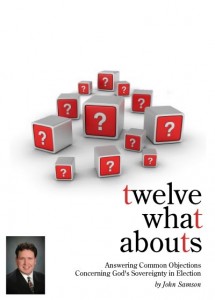 From the new book, here’s an excerpt from the chapter entitled “A Word to the Reader”:
From the new book, here’s an excerpt from the chapter entitled “A Word to the Reader”:
One amongst many sound principles of interpretation is that we should build all doctrine on necessary rather than possible inferences.
A necessary inference is something that is definitely taught by the text. The conclusion is unavoidable. It is necessary.
A possible inference is something that could or might be true, but not something actually stated by the text. Some refer to this as the distinction between the implicit and the explicit.
An implication may be drawn from the text of Scripture, but we then have to ask if the implicit interpretation is a NECESSARY ONE rather than a POSSIBLE one. We all have our theories, but a sound principle we should employ is to not believe or teach as doctrine something that is only a possible interpretation. We should build doctrine ONLY on necessary interpretation.
In practical terms, making these distinctions can sometimes be a difficult process because it means we have to take a step back and thoroughly analyze exactly why we think a verse or passage teaches something. In other words, it means testing our traditions and doing a lot of thinking. Yet this is something we should do constantly.
THINK OVER WHAT I SAY
Paul exhorted Timothy to “Think over what I say, for the Lord will give you understanding in everything.” (2 Tim 2:7)
All of us should be prepared to hold up our preconceived notions to the light of Scripture to see if these assumptions are valid or not. The result of this process often involves the killing of some sacred cows; but that’s a good thing, if what we have held to be true cannot actually be supported by the biblical text. We all have our blind spots and traditions, but we are not always aware of them. Therefore, the serious Bible student asks questions of the text constantly in order to determine what the sacred text actually says and then builds all thinking and doctrine on that.
 Here’s one text as an example: John 20:19 says, “On the evening of that day, the first day of the week, the doors being locked where the disciples were for fear of the Jews, Jesus came and stood among them and said to them, ‘Peace be with you.’”
Here’s one text as an example: John 20:19 says, “On the evening of that day, the first day of the week, the doors being locked where the disciples were for fear of the Jews, Jesus came and stood among them and said to them, ‘Peace be with you.’”
Many people read this passage and conclude that Jesus walked through the locked door in order to present Himself to His disciples.
But does the text actually say that? No, it does not. The text MIGHT be teaching that. It is certainly a possible inference drawn from the text, but by no means a necessary one. There are other possible explanations.
Concerning this verse the ESV Study Bible says (correctly in my opinion), Some interpreters understand the doors being locked to imply that Jesus miraculously passed through the door or the walls of the room, though the text does not explicitly say this. Since Jesus clearly had a real physical body with flesh and bones after he rose from the dead… one possibility is that the door was miraculously opened so that the physical body of Jesus could enter, which is consistent with the passage about Peter going through a locked door some time later (see Acts 12:10).
To state the principle again: we should build all doctrine on necessary rather than possible inferences, on the explicit and not the implicit. All else is speculation.
